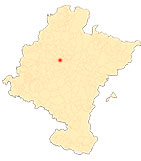The memorial in Pamplona
Pompey Monument
-
Author: José Antonio Eslava Urra.
-
Materials and technique: Bronze.
-
Bust: black beaten iron plates. Monolith: white cement.
-
Dimensions: Torso: 180 cm; Monolith: 800 x cm.
-
Location: Roundabout at place Juan XXIII.
-
Date of installation: 31 December 1992 (inauguration).
The general and politician Pompey Pompey Magnus was one of the great strategists of his time and, according to tradition, the founder of the city of Pamplona. In the campaign of the Sertorian Wars in Hispania, he decided to withdraw in the winter of 75-74 BC to the allied territory of the Vascons, where he established a military camp to which he gave his name.
In 1992, Pamplona City Council commissioned José Antonio Eslava to create a sculpture in homage to Pompey, fulfilling a dual function of ornamentation and reflection on the city's historical references. The sculptural ensemble consists of an eight-metre-high white cement monolith, on the south face of which is an engraving of a symbolic nature with the three concepts that for Eslava make up the idea of Pamplona: the city, the slope of the city walls and the meanders of the river Arga.
To its north face is attached a torso worked in beaten iron representing General Pompey, in which Eslava opted for a formula that combines tradition and modernity. He thus conceived a figure whose origins lie in the portrait of the Roman period, with the outlines of the cloak falling from the general's right shoulder, but whose formal execution is inspired by the freer language of Henry Moore's organicist sculpture. He also tried to reconcile the contemplative and active attitudes, as the concentrated, reflective gesture of the face defines the countenance of a man who thinks about the city; however, the pronounced pectorals and muscular belly reveal his warrior status. The result is a combination of powerful volumes that respects the austerity and strength of Roman busts, but translated into the language of our time.
-
AZANZA LÓPEZ, J. J., The commemorative monument in Navarre. The identity of a Kingdom. Col. Panorama, nº 31, Pamplona, Government of Navarre, 2003.
-
AZANZA, J. J., MURUZÁBAL, J. M., URRICELQUI, I. and ZUBIAUR, F. J., Guía de escultura urbana en Pamplona, Pamplona, Pamplona City Council, 2009.












